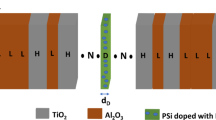Abstract
AN important method in the preparation of pure silicon for semiconductor devices is the silicon iodide process1. In this method silicon tetraiodide is formed from the elements and purified by fractional distillation before being decomposed by passage over a heated tantalum filament. We have found by radio-activation analysis2 that the predominating N-type impurity in silicon produced by this method in our laboratory is phosphorus, and that its concentration seems to be largely independent of the phosphorus content of the ‘crude’ silicon. This could be explained if there was an appreciable phosphorus-level in the iodine used, as the mass ratio of silicon to iodine in the above reaction is about one to twenty. Therefore we developed the following method for estimating the phosphorus content of iodine.
This is a preview of subscription content, access via your institution
Access options
Subscribe to this journal
Receive 51 print issues and online access
$199.00 per year
only $3.90 per issue
Buy this article
- Purchase on SpringerLink
- Instant access to full article PDF
Prices may be subject to local taxes which are calculated during checkout
Similar content being viewed by others
References
Andersen, H. C., and Belz, L. H., J. Amer. Chem. Soc., 75, 4828 (1953).
James, J. A., and Richards, D. H., Nature, 176, 1026 (1955).
Author information
Authors and Affiliations
Rights and permissions
About this article
Cite this article
JAMES, J., RICHARDS, D. Radioactivation Analysis of Phosphorus in Iodine. Nature 177, 1230 (1956). https://doi.org/10.1038/1771230a0
Issue date:
DOI: https://doi.org/10.1038/1771230a0



